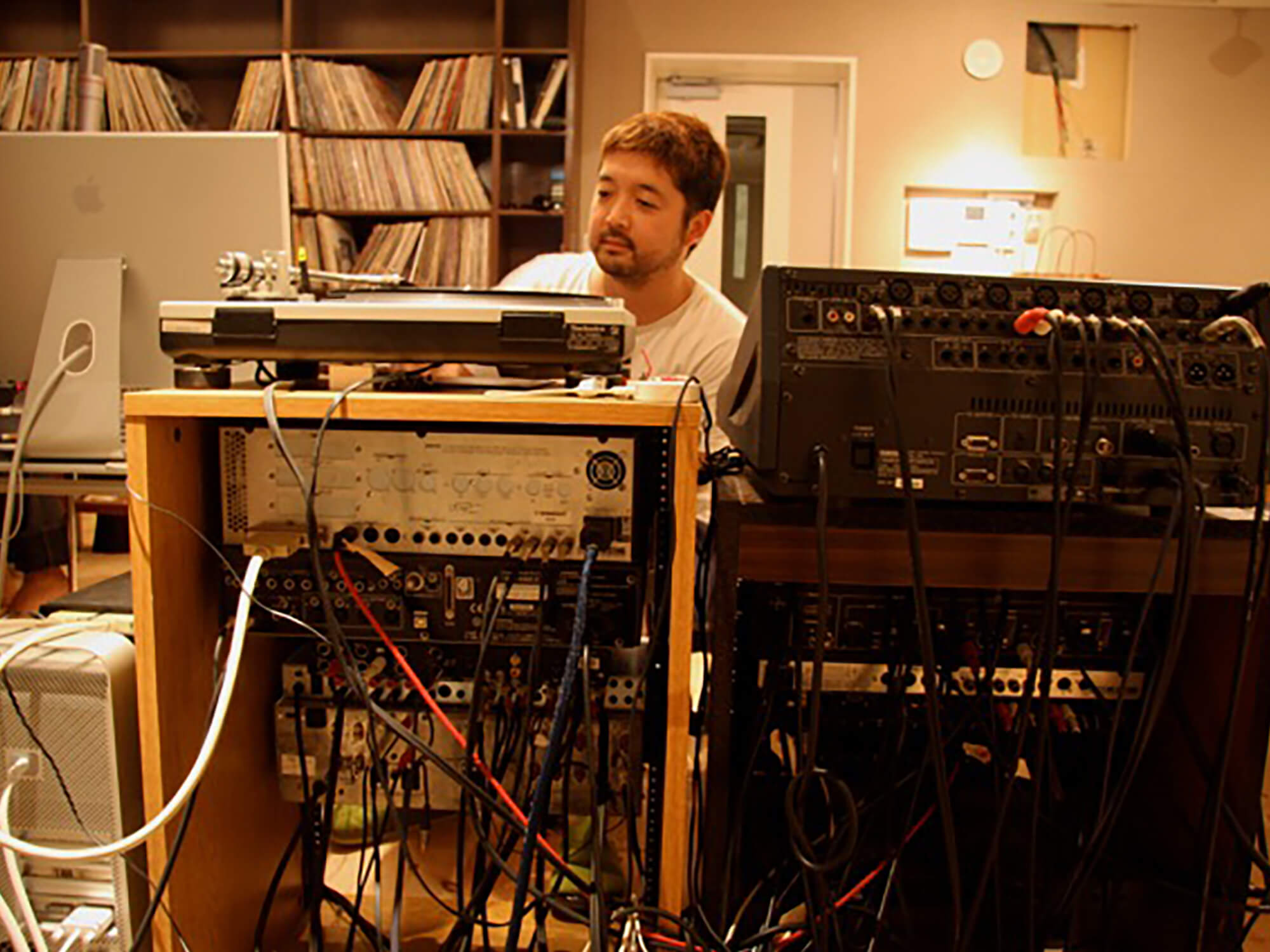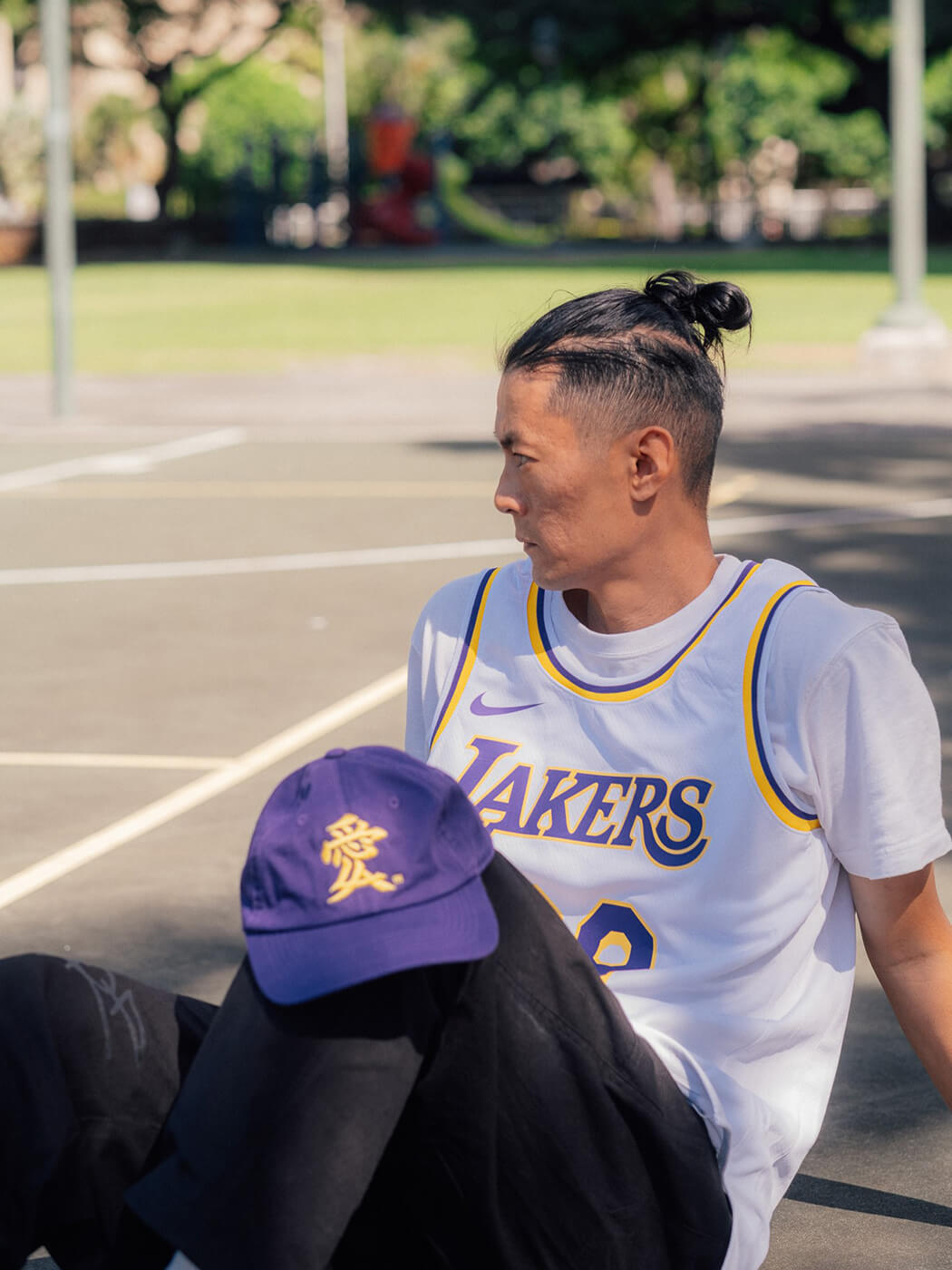Light as a feather: Nujabes’ lasting impact on hip-hop and electronic music
This year, Nujabes would have turned 50. We look at how the Japanese beatmaker upended hip-hop without even trying, and how his legacy continues to inform modern music production.

Nujabes in his studio. Image: Yosuke Moriya
Beatmaker, producer, DJ, musician, crate digger, record store and label owner — Nujabes did it all. Tokyo born and raised, he soaked up inspiration from the overseas jazz and hip-hop music that he loved, flipped the script, and sent it back west, in turn influencing the countless producers that have come after him. His life was sadly cut short in 2010 at 36 years old, but his records continue to inform and inspire, with lo-fi hip-hop as just one modern manifestation of his output.
To understand his music — and the outsized influence his work has had on modern music — first you have to understand Tokyo.
Birth of the modal soul
Up the hill from Shibuya’s famous Scramble intersection, where tourists and locals alike jostle to make it across the road unscathed, lies Udagawa-cho. Packed with tiny record stores aimed at working DJs, you can find anything you want, including hip-hop, house, downtempo and jazz. It was here that Jun Seba, later known as Nujabes, owned not one but two record shops: Guinness Records (we advise taking a tour here) and Tribe. Amidst this mix of genres is where Nujabes’ journey as one of the most important hip-hop producers ever began. And, if you know Shibuya, the youth and music epicentre of Tokyo, it couldn’t have happened any other way.
Born Jun Yamada just a few miles away from Shibuya, he took the pen name Jun Seba when he began writing for Japanese music magazines. Staking his claim in Udagawa-cho with his record stores, he soon added beatmaker to his growing list of talents. Flipping his name like a sample, he quietly announced himself as Nujabes with a bootleg 12-inch remix of Nas dropped surreptitiously into the bins of his own stores.
Rather than toot his own horn, he preferred to sample the horns of others. A consummate sample spotter, his chosen melodic jazz riffs and boom-bap-inspired beats were like nothing else around. His debut album, 2003’s Metaphorical Music, confirmed that a rare talent had arrived, with its release and the precious few that followed before his death creating ripples throughout the music world like pebbles dropped into a placid temple pond.
Nujabes’ production style: deceptively simple
Nujabes’ music has the same core pieces as many other hip-hop records, namely jazzy melodies and sampled breakbeats, and yet there’s no mistaking a Jun Seba production. Relaxed and spiritual but always emotional, his songs have a unique flavour that sets them apart from others.
Frequent collaborator Shing02, who rapped on several Nujabes cuts including the incredible Luv(sic) Hexology, puts it this way to us: “Overall, the Japanese minimalist aesthetic and interpretation of 90s hip-hop shaped the sound of his beats. They were deceptively simple in terms of composition.”
Deceptively simple is the key. Break down any of his tracks and you’ll find precious few elements: a sampled beat left largely in peace, a melodic bar or two snatched from a classic jazz record, and possibly a counter melody, either sampled or played live. And that’s it.

An instinct for discovering samples
It was the choice of samples, though, that made his music unique.
“Honestly it’s hard to articulate why,” answers Shing02 when we ask him about Nujabes’ ever-increasing popularity. “But, musically speaking, he did have a knack for discovering samples, whether they were famous artists or not. His huge vinyl collection was a testament to how much time he spent listening to records.”
Nujabes was a crate digger first and foremost. He did own two record stores, after all. It’s easy to imagine him spending his afternoons in the records stores of Shibuya and nearby Shinjuku, searching for bottled magic to release from locked grooves.
But more than just finding obscure records to sample, he had an ear for melody, for the most emotional bits of a track to use in his compositions. Rather than pull out unrelated snippets, he preferred to let the original tracks define the chord progressions. He respected the songs.
Unlike J Dilla who, as well as being born on the exact same day as Nujabes, transformed our understanding of rhythm, Nujabes amplified our appreciation of melody. Armed with hardware samplers like the Akai MPC 2500 and 2000XL and Akai S950, plus a keen understanding of what makes records work, he was able to craft new records that built on the melodic explorations of jazz masters like Miles Davis and Pharoah Sanders and Brazilian artists such as Luiz Bonfá and Toquinho.
Jazztown Tokyo
It’s hard to oversell the importance of jazz to many Tokyo-ites. Jazz greats like Duke Ellington and Herbie Hancock regularly played massive concert halls in the Japan capital. Listening bars and cafes, presided over by audiophile owners with massive jazz collections, dot the landscape. Even famous author Haruki Murakami owned a jazz cafe in his early days.
This love of jazz and other American music permeates the Tokyo scene and it’s this saturated environment that Nujabes grew up in. Always the guy asking the DJ the name of the record playing, he loved music to such an extent that he wanted to celebrate it with samples. His music succeeds because of his deep love for the source material.
The lo-fi connection
Of course, Nujabes’ productions are more than just a few well-selected samples. There’s a whole vibe to them; an aesthetic that set down the blueprint for the genre of lo-fi hip-hop.
While not specifically lo-fi in the modern sense, Nujabes’ tracks are warm and unpolished, with a high-frequency roll-off that you don’t hear in other cuts from the era. This most likely comes from the source material, largely 1960s and 70s records captured from vinyl.
His use of effects also makes him stand out from other hip-hop producers. Nujabes often coated his samples in modulation and sometimes even delay. Another common Nujabes trick is to cut out all the highs and boost resonance with a Waldorf 4-Pole analogue filter, a practice more common in house than hip-hop. He’s even been known to use a filtered layer of the same sample underneath as a bassline. Throw in some imperfectly chopped samples with audible onset pops and clicks and you have the makings of proto-lo-fi beats.
Choice of a new generation
We can’t talk about Nujabes without mentioning Samurai Champloo, the 2004 anime series that Nujabes made the soundtrack for. A melding of Japanese and hip-hop stylings, it failed to make much of an impact in its country of origin. However, it was a hit overseas, and many who grew up watching it — and hearing Nujabes’ unique beats soundtracking the action — have since gone on to become lo-fi hip-hop producers themselves.
“For boys around the world who were still young at the time, Samurai Champloo was a very interesting anime,” says Japanolofi Records on its site. “Not only was the quality of the work high, but the music, which was smooth, jazzy, comfortable, and somehow hip-hop … left a strong impression on them.”
There’s a deep sense of nostalgia that permeates lo-fi hip-hop and harkens back to a relaxed, analogue time before our modern and anxiety-fueled digital age. Nujabes’ music fits this perfectly.
According to Japanolofi Records, Nujabes tried to pioneer a more laid-back, non-aggressive style of hip-hop. “Nujabes’ style of sampling always employed vinyl records to create warm noises, and (his) music tended to lean toward jazz and soul, so there is no doubt that (it) created a relaxing sound,” the label sums up. “The essence of such music permeated the world and created the lo-fi hip-hop sound.”
The anime connection
Nujabes’ influence has lately transcended from lo-fi hip-hop to background music for social media users and content creators. Whether in its original form or remixed, Araurian Dance from Samurai Champloo has become the go-to soundtrack for the internet.
And then there’s the anime connection. The face of the chill genre is the lo-fi study girl, a short animation of a teen girl sitting at a desk by an open window, drawn in a very Studio Ghibli style. The visual component to YouTube streaming channel lo-fi hip hop radio, it’s the end point of a variety of threads that, once you start pulling, go all the way back to Samurai Champloo and Nujabes.
Towards the future (passed)
This year, Nujabes would have turned 50. It’s tempting to wonder how his music may have evolved had his life not been cut short by a car accident.
“Surely he would have appreciated it,” answers Shing02 when asked how Nujabes may have reacted to the modern adulation of his music, “but I’m not sure what kind of music he would be making. Towards the end, he was gravitating towards making faster BPMs and more live instrumentation.”
Like an apprentice studying at the feet of the jazz masters of the past, Nujabes moved on from just sampling towards using more live instruments in his music, as Shing02 mentions, either playing them himself or alongside collaborator and jazz musician Uyama Hiroto.
Uyama’s Nujabes-produced album A Son of the Sun could offer clues as to what a future Nujabes may have sounded like. A true fusion of hip-hop and jazz, it’s a heady album for heads and modal jazz fans alike. Had he been able to keep on producing, would we have seen a Galaxy 2 Galaxy-like touring live band combining hip-hop, jazz and Brazilian sounds? The mind boggles.
We may not have new Nujabes music, but we do have new music descended from his DNA in lo-fi artists like Eevee and Tomppabeats, as well as those he worked with like Shing02, who keeps Nujabes’ legacy alive in his live shows.
“As far as our catalogue together that spanned 10 years, it is always going to be a part of our live performances,” he says. “I try to embody what our spirit was like creating those songs.”
In Japanese religious beliefs, the spirit can become a kami, a kind of god after death. Hip-hop has many kami, from Tupac to Biggie, and Nujabes is surely among them, helping guide modern music to a more chill and emotional place.